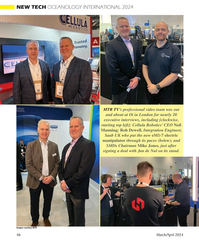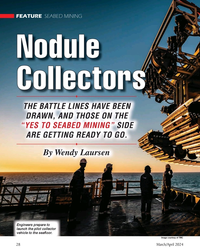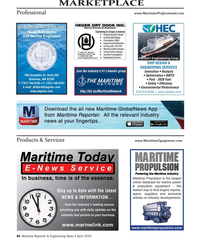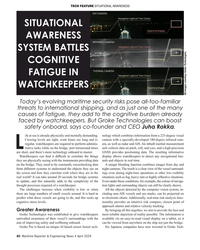Procurement And Engineering Programs Navy
-
- N A V Y — A $35-BILLION ANNUAL MARKET Maritime Reporter, Mar 1989 #25
The Outlook For U.S. Navy Shipbuilding and Ship Repair Sales of equipment and services to the U.S. Navy continue to be the major source of business for marine equipment manufacturers. The U.S.
Navy represents an annual sales market totaling $35.0 billion—excluding aircraft procurement, personnel and other non-relevant expenditures.
Despite recent efforts to cut the growth of overall defense expenditures, the Navy maintains a strong position.
There continues to be tremendous opportunities for increased product, sales and market expansion as a result of the huge amount of business generated by the Navy ongoing purchases.
OVERALL DEFENSE BUDGET In January, President Reagan submitted a defense budget request for $315.2 billion in FY 1990 and $330.8 billion in FY 1991. This represents a rate of increase of about 5 percent per year over current spending— or 2 percent per year if inflation is taken into account. Details for budget authority and outlays are shown in Exhibit 1.
P r e s i d e n t Bush will make changes to this budget request, which likely will result in a reduction in proposed overall defense spending and stretch-out of some major programs. These changes are not known at time of publication.
NAVY BUDGET The proposed Navy budget is $101.7 billion in FY 1990 and $105.1.
billion in FY 1991. This would represent a three to four percent increase over current spending. Described below are Navy's plans and budget for major program activities over the next several years.
SHIPBUILDING Navy has requested $10.4 billion in FY 1990 to fund construction of 20 new ships and two major conversions.
The amount of $9.8 billion is requested in FY 1991 to build 14 ships—including two follow ships in the SSN 21 attack submarine program.
Exhibit 2 shows a ten-year pattern of spending for ship construction.
One column shows total obligational authority—the figure which essentially sets the limit on the agency's contractual authority. The other column shows the actual outlays in each year—representing pay- ments to contractors for ships and equipment. Outlays best indicate the level of business activity generated by Navy spending.
As shown, outlays will grow from $8.9 billion in FY 1988 to $10.9 billion in FY 1991. This growth occurs despite the fact that obligational authority is much lower in FY 1991 than FY 1988.
Shown in Exhibit 3 is the breakdown of the shipbuilding budget request for the FY 1988-1991 period.
Exhibit 4 shows the projected program over the next five years.
A major change in the future program has been the deletion of three SSN 688 submarines originally planned for FY 1991 and 1992.
There had been criticism of Navy's plan to overlap construction of the SSN 21 and SSN 688. The current plan is now to end the SSN 688 program in FY 1990. In FY 1991 Navy plans to order two SSN 21's and maintain a construction rate of three per year thereafter.
Navy plans to build DDG 51 Aegis destroyers at the rate of five per year over the next five years. This program is a target for budget cutting— most likely by stretch-out— building fewer ships per year over a longer period.
Other changes from last year's plan include a change in timing for several programs—including the AOE fast combat support ship, LHD amphibious assault ship and TAGOS survelliance ship. Three MCM mine countermeasure ships have been added for FY 1990.
SHIP REPAIR Expenditures for ship maintenance are projected to increase over the next two years. Navy plans to spend $5.2 billion in FY 1990 and $5.4 billion in FY 1991 for active fleet ship maintenance and modernization.
These figures compare with projected spending of $4.7 million for ship maintenance and modernization in FY 1989. Details are shown in Exhibit 5. In addition, $208.0 million is to be spent on reserve fleet ship maintenance in FY 1990—vs.
$199.0 million in FY 1989.
Despite the planned increase in funding for ship maintenance, the number of planned availabilities is projected to significantly decline over the next two years. In FY 1989, Navy has scheduled 149 availabilities of active fleet ships. This figure is projected to rise to 154 in FY 1990—and then fall to 128 in FY 1991. The number of ship overhauls will decline from 25 in FY 1989 to 15 in FY 1990 and 12 in FY 1991. Compared to this year, the number of short term planned availabilities will increase somewhat in FY 1990 but decline significantly in FY 1991.
Major factors driving projected ship overhaul spending are two carrier overhauls. A regular carrier overhaul is scheduled in FY 1990. A major refueling overhaul is scheduled for the nuclear carrier Enterprise (CVN 65) in FY 1991. These two work starts will consume a substantial portion of the overhaul budget.
As a consequence, a rising budget will not result in corresponding additional work opportunities.
OTHER PROCUREMENT AND ENGINEERING PROGRAMS Navy spending for "other procurement" is projected to be $4.7 billion in FY 1989. This figure is projected to rise to $5.0 billion in FY 1990 and $5.7 billion in FY 1991.
The major reason for the increase is additional funding for communications and electronics equipment.
Much of the increase is the result of major initiatives associated with submarine modernization programs.
Funding of research, development, test and evaluation (RDT&E) is projected to grow f r om $9.3 billion in FY 1989 to $10.2 billion in FY 1990. Much of t h e increase is associated with increased spending for tactical programs which are entering full scale engineering development.
MILITARY CONSTRUCTION The Navy budget for military construction will decline from $1.6 billion in FY 1989 to $1.1 billion in FY 1990. The FY 1990 request cont a i n s funding for the strategic homeporting initiative—including $30.9 million for developing the New York homeport, $33.5 million for Gulf Coast sites and $20.3 million for t h e Everett homeport. However, a recent recommendation of t h e Base Closure Commission will likely result in lowered funding for Gulf Coast sites.
-
 )
March 2024 - Marine Technology Reporter page: 48
)
March 2024 - Marine Technology Reporter page: 48Index page MTR MarApr2024:MTR Layouts 4/4/2024 3:19 PM Page 1 Advertiser Index PageCompany Website Phone# 17 . . . . .Airmar Technology Corporation . . . . . . . . . .www.airmar.com . . . . . . . . . . . . . . . . . . . . . . . . . . . . . . . . .(603) 673-9570 9 . . . . . .Birns, Inc. . . . . . . . . . .
-
 )
March 2024 - Marine Technology Reporter page: 46
)
March 2024 - Marine Technology Reporter page: 46NEW TECH OCEANOLOGY INTERNATIONAL 2024 MTR TV’s professional video team was out and about at Oi in London for nearly 20 executive interviews, including [clockwise, starting top left]: Cellula Robotics’ CEO Neil Manning; Rob Dewell, Integration Engineer, Saab UK who put the new eM1-7 electric manipulator
-
 )
March 2024 - Marine Technology Reporter page: 42
)
March 2024 - Marine Technology Reporter page: 42NEW TECH OCEANOLOGY INTERNATIONAL 2024 Image courtesy Greg Trauthwein Image courtesy BIRNS MacArtney launches the new ultra-compact ø12.7 mm SubConn Nano connector. Innovative connectivity built on 45 years of ? eld-proven and market-trusted design. Image courtesy MacArtney Birns celebrated its 70th
-
 )
March 2024 - Marine Technology Reporter page: 39
)
March 2024 - Marine Technology Reporter page: 39Photo courtesy Global Ocean Design Figure 7 A 35Ah AGM lead-acid battery is tested using the West Mountain Radio CBA to show the effect of simply ? lling the battery voids with mineral oil as a compensating ? uid. The CBA is programmed to cut-off at a voltage of 10.50v. The top line (red) shows the
-
 )
March 2024 - Marine Technology Reporter page: 38
)
March 2024 - Marine Technology Reporter page: 38LANDER LAB #10 Photo courtesy West Mountain Radio Photo courtesy of Clarios/AutoBatteries.com Figure 6 The West Mountain Radio Computerized Battery Analyzer (CBA V) attaches to a Figure 5 laptop by a USB-B cable, and to a battery by Powerpole® Connectors. Exploded view of an AGM lead-acid battery.
-
 )
March 2024 - Marine Technology Reporter page: 35
)
March 2024 - Marine Technology Reporter page: 35Figure 1 A self-righting vehicle design with buoyancy high and weight low, WHOI’s SeaBED AUV captures the attention of a pair of curious Antarctic penguins as it is deployed from the British research vessel James Clark Ross. Vehicle designers allowed for temperature reduction of battery capacity. Recharge
-
 )
March 2024 - Marine Technology Reporter page: 32
)
March 2024 - Marine Technology Reporter page: 32FEATURE SEABED MINING by a sea? oor plume from its pilot collection system test. pact, nodule collection system that utilizes mechanical and The Metals Company recently signed a binding MoU with hydraulic technology. Paci? c Metals Corporation of Japan for a feasibility study on The company’s SMD
-
 )
March 2024 - Marine Technology Reporter page: 28
)
March 2024 - Marine Technology Reporter page: 28FEATURE SEABED MINING Nodule Collectors THE BATTLE LINES HAVE BEEN DRAWN, AND THOSE ON THE “YES TO SEABED MINING” SIDE ARE GETTING READY TO GO. By Wendy Laursen Engineers prepare to launch the pilot collector vehicle to the sea? oor. Image courtesy of TMC 28 March/April 2024 MTR #3 (18-33).
-
 )
March 2024 - Marine Technology Reporter page: 26
)
March 2024 - Marine Technology Reporter page: 26FEATURE OCEANOGRAPHIC INSTRUMENTATION & SENSORS Kevin Mackay, TESMaP voyage leader and Center head of the South and West Paci? c Regional Centre of Seabed 2030. Kevin in the seismic lab at Greta Point looking at the Hunga Tonga-Hunga Ha’apai volcano 3D map completed with data from the TESMaP voyage
-
 )
March 2024 - Marine Technology Reporter page: 19
)
March 2024 - Marine Technology Reporter page: 19About the Author vey with the pipe tracker is not required, resulting in signi? - Svenn Magen Wigen is a Cathodic Protection and corrosion control cant cost savings, mainly related to vessel charter. expert having worked across The major advantage of using FiGS on any type of subsea engineering, design
-
 )
March 2024 - Marine Technology Reporter page: 15
)
March 2024 - Marine Technology Reporter page: 15sensor options for longer mission periods. About the Author For glider users working in ? sheries and conservation, Shea Quinn is the Product Line Manager the Sentinel can run several high-energy passive and active of the Slocum Glider at Teledyne Webb acoustic sensors, on-board processing, and imaging
-
 )
March 2024 - Marine Technology Reporter page: 14
)
March 2024 - Marine Technology Reporter page: 14TECH FEATURE TELEDYNE SLOCUM GLIDERS to hold over 3.5 times as many lithium primary batteries as the the water column and its thrusters give it the ability to stay standard Slocum Glider, and to physically accommodate up to on track in strong currents or other dif? cult ocean condi- 8 different sensor
-
 )
March 2024 - Marine Technology Reporter page: 13
)
March 2024 - Marine Technology Reporter page: 13nyone familiar with glider hardware options integrated for a broad Glider answers that need,” said Shea autonomous underwater ve- range of missions. Quinn, Slocum Glider Product Line hicles (AUVs) is certainly “As the use of Slocum Gliders grew, Manager at TWR. A familiar with the popular- so did
-
 )
March 2024 - Marine Technology Reporter page: 12
)
March 2024 - Marine Technology Reporter page: 12TECH FEATURE TELEDYNE SLOCUM GLIDERS Teledyne Webb Research Engineers deploy the Slocum Sentinel Glider in Cape Cod Bay for testing. Teledyne Webb Research AS THE GLIDER COMMUNITY GROWS, SO DO GLIDERS By Shea Quinn, Slocum Glider Product Line Manager, Teledyne Marine 12 March/April 2024 MTR #3 (1-17).
-
 )
March 2024 - Marine Technology Reporter page: 11
)
March 2024 - Marine Technology Reporter page: 11assist in identifying mines and act as a neutralization device. About the Author Bottom mines pose even greater chal- David R. Strachan is a defense analyst and founder of lenges. Unlike contact mines, bottom Strikepod Systems, a research and strategic advisory mines utilize a range of sensors to
-
 )
March 2024 - Marine Technology Reporter page: 9
)
March 2024 - Marine Technology Reporter page: 9from marinas along the western coast. The exact number of lizing laser detection systems can detect mines just below the mines, as well as their locations, remains largely a mystery, surface, even those hiding in murky water. The Airborne Laser although reports suggest that over three hundred have been
-
 )
March 2024 - Marine Technology Reporter page: 6
)
March 2024 - Marine Technology Reporter page: 6MTR Editorial Advisors Gallaudet Hardy The Honorable Tim Gallaudet, Kevin Hardy is President PhD, Rear Admiral, U.S. of Global Ocean Design, Navy (ret) is the CEO of creating components and Ocean STL Consulting and subsystems for unmanned host of The American Blue vehicles, following a career
-
 )
April 2024 - Maritime Reporter and Engineering News page: 48
)
April 2024 - Maritime Reporter and Engineering News page: 48Index page MR Apr2024:MN INDEX PAGE 4/5/2024 1:33 PM Page 1 ANCHORS & CHAINS MILITARY SONAR SYSTEMS tel:+44 (0) 1752 723330, [email protected] , www.siliconsensing.com Anchor Marine & Supply, INC., 6545 Lindbergh Houston, Massa Products Corporation, 280 Lincoln Street, SONAR TRANSDUCERS
-
 )
April 2024 - Maritime Reporter and Engineering News page: 46
)
April 2024 - Maritime Reporter and Engineering News page: 46MARKETPLACE Professional www.MaritimeProfessional.com GILBERT ASSOCIATES, INC.GILBERT ASSOCIATES, INC. Naval Architects and Marine Engineers SHIP DESIGN & ENGINEERING SERVICES Join the industry’s #1 Linkedin group )NNOVATION
-
 )
April 2024 - Maritime Reporter and Engineering News page: 43
)
April 2024 - Maritime Reporter and Engineering News page: 43“The industry is an ecosystem which includes owners, managers, mariners, shipyards, equipment makers, designers, research institutes and class societies: all of them are crucial,” – Eero Lehtovaara, Head of Regulatory & Public Affairs, ABB Marine & Ports All images courtesy ABB Marine and Ports provi
-
 )
April 2024 - Maritime Reporter and Engineering News page: 42
)
April 2024 - Maritime Reporter and Engineering News page: 42OPINION: The Final Word Seeing the Ship as a System Shipping must engage with the decarbonization realities that lie ahead by changing the way it crafts maritime legislation to re? ect its place in the interconnected, interdependent world economy, said Eero Lehtovaara, ABB Marine & Ports. ABB Marine &
-
 )
April 2024 - Maritime Reporter and Engineering News page: 41
)
April 2024 - Maritime Reporter and Engineering News page: 41Nautel provides innovative, industry-leading solutions speci? cally designed for use in harsh maritime environments: • GMDSS/NAVTEX/NAVDAT coastal surveillance and transmission systems • Offshore NDB non-directional radio beacon systems for oil platform, support vessel & wind farm applications
-
 )
April 2024 - Maritime Reporter and Engineering News page: 40
)
April 2024 - Maritime Reporter and Engineering News page: 40TECH FEATURE SITUATIONAL AWARENESS SITUATIONAL AWARENESS SYSTEM BATTLES COGNITIVE FATIGUE IN WATCHKEEPERS All images courtesy Groke Technologies Today’s evolving maritime security risks pose all-too-familiar threats to international shipping, and as just one of the many causes of fatigue, they add
-
 )
April 2024 - Maritime Reporter and Engineering News page: 38
)
April 2024 - Maritime Reporter and Engineering News page: 38Tech Files Latest Products, Systems and Ship Designs Zero-Emission Mooring Service of a Tanker Consulmar achieved a milestone by executing what it calls ing boat Castalia, which operates on full electric propulsion. the world's ? rst zero-emissions mooring service for a tanker. Equipped with two 150 kW
